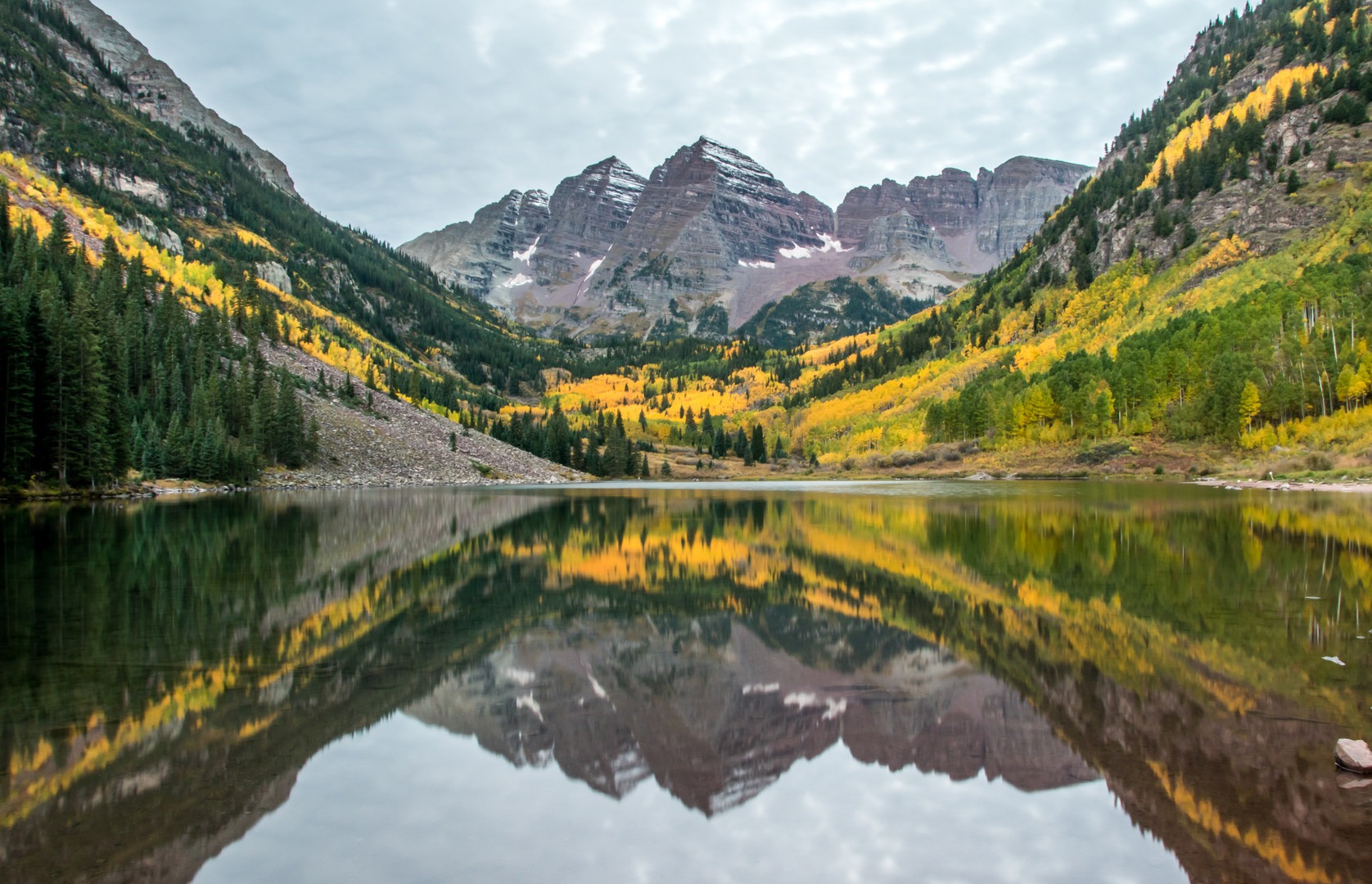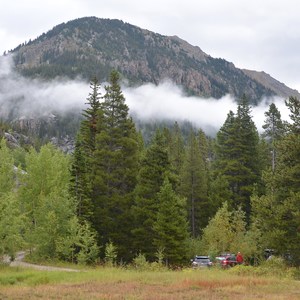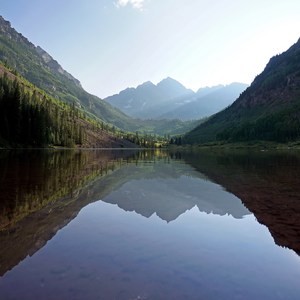Maroon Bells is widely regarded as one of Colorado’s most photographed wilderness scenes, and for good reason. The view of the twin peaks is like something you might find in a Bob Ross painting, an alpine lake lapping the steep slopes of a happy little alder-spackled mountain valley, framing the 14,000-foot domes several miles away.
The peaks earn their name from the unusual composition of their rock, which is not so much rock but compressed mudstone known as hematite, an iron-rich, friable, and extremely dangerous stone that has claimed enough lives over the years to earn the more foreboding nickname, the Deadly Bells. But as the centerpiece of the Maroon Bells-Snowmass Wilderness, one of Colorado’s most heavily visited wilderness preserves, the peaks can do no wrong.
Considered alone, the Maroon Bells-Snomass Wilderness is a small parcel of rugged alpine terrain south of Aspen, Colorado, but it nonetheless claims some fantastic backcountry adventures. Most of the wilderness hikes begin at or above 8,300 feet and ascend rapidly from there. With quick access to the resort amenities in Aspen, adventurers can visit Maroon Bells year round. The best time to visit, however, is between April and November, between the spring wildflower bloom and the fall colors of Aspen’s foliage. Fun fact: groves of aspen are considered a single organism, genetically identical clones of one another that propagate from a common root system to colonize environments recovering from avalanche or wildfire.
To fully enjoy all that Maroon Bells has to offer, camp at one of three Forest Service campsites along Maroon Creek Road, just northeast of Maroon Lake (reservations recommended) or hike up to primitive backcountry sites at elevation. Whatever you do, make sure to check in with the Forest Service to adhere to backcountry regulations. Officials are working hard to manage the growing popularity of this area with respect for the wildlife that live here; recently there have been challenges with human-bear interactions that have led the Forest Service to require bear canisters for all overnight visitors. Please follow this important guideline and show up with your own canister before you hit the trailhead. Also, campfires above 10,800 feet have recently been prohibited. Maroon Bells is a sensitive wilderness area, so as you visit, be aware of your impact and always try to Leave No Trace.
For the Easy-Going
Note: any of these hikes convert well to snowshoe or cross-country skiing excursions during the spring. During the winter, consider a tour by snowmobile.
Fortunately, the most recognizable scene at Maroon Bells is also its most accessible. Maroon Lake Trail is a short hike around Maroon Lake, less than a mile long and perfect for those who want to soak in the view. Fishers with a Colorado fishing license can cast here. Be forewarned: 300,000 people visit the park each season, and most of them come here. Word to the wise: watch the sun rise.
The Scenic Loop Trail is substantially longer than the Maroon Lake Trail at three miles, but is still relatively flat. Enjoy the small waterfalls behind Maroon Lake without the exhaustion of a high-altitude hike.
Maroon Creek Trail (3 miles) passes through Stein’s Meadow and offers a good chance of seeing wildlife. When started at Maroon Lake, it is an 800-foot descent to the East Maroon Wilderness Portal, where hikers can pick up the bus back to Aspen or head to campsites northeast along Maroon Creek Road.
Perhaps a bit more challenging, Crater Lake Trail (3.6 miles round-trip, 500 feet in elevation gain) passes through the steep valley between Sievers Mountain and Pyramid Peak to the base of Maroon Bells. It is nearly as beautiful as Maroon Lake, and access may be the only factor that makes Maroon Lake a more recognizable scene. Heavy impact in the area has led the Forest Service to prohibit camping, which used to be allowed at Crater Lake. Don’t fret—backcountry camping is allowed nearby in Minnehaha Gulch.
Ascend, Human!
The Willow Lake Trail (13 miles round-trip) curls 3,100 feet to the backside of Sievers Mountain. The sparse terrain exposes hikers to dangerous wind and weather, and many might consider spending the night at Minnehaha Gulch. Those who rise to the challenge will find a little aquamarine jewel near tree line with vistas to the northwest. The strain pays off with seclusion.
Copper Lake Trail (about 10.5 miles one-way) to Copper Lake via East Maroon Creek is the longest single-destination hike in Maroon Bells and rises nearly 3,000 feet in elevation. Like Willow Lake, its beautiful aquamarine waters are just below tree line, sparsely forested and similarly exposed. Those who prize the destination more than the journey should consider an approach from the south: Copper Lake Trailhead in Gunnison National Forest is a scant 3.5 miles away from the lake.
Conundrum Hot Springs is one of Maroon Bells more unique features. Nine miles south from Conundrum Trailhead, the small pool is set 2,440 feet above a broad alpine valley and Conundrum Creek. With designated campsites around the springs, intrepid hikers can hike around Hilliard Peak to Copper Lake and north to Maroon Bells and camp in these specified areas (note that camping is not allowed within a quarter-mile of the hot springs). Clothing is optional here, and dogs are not permitted at the hot springs.
Sometimes, I Prefer to Be Alone
On Maroon Bells’ eastern flank, away from the hubbub of Maroon Lake, Cathedral Lake Trail (2.5 miles, 2,000 feet elevation gain) ascends to a similar alpine spectacle without the chaos of photographers. Cathedral Peak and Leahy Peak show off the same ruddy rock, and it is short enough to keep within an afternoon. For a longer option with spectacular 360-degree views, take the trail up to Electric Pass at 13,635 feet.
American Lakes Trail from American Lakes Trailhead (about 3 miles) is a charming pair of lakes set high on a shelf above Ashcroft (see below) that look a little bit like a map of the Americas. Note that both the American Lakes Trail and the Cathedral Lakes Trail are popular spots, so expect to have company on the weekends and holidays.
More Machine Now Than Human
Twisted and evil, the Four Pass Loop is also a scenic getaway over many miles and many more feet in elevation gain that crosses into the Snowmass area, beginning at Maroon Bells and looping east toward Snowmass Mountain before returning to Maroon Lake via Willow Lake. This hike is popular with the multi-day crowd.
Points of Interest
Crystal Mill is a relic of Colorado’s mining past and was used to aid silver miners in the area until 1917. The wooden mill still stands 100 years later.
Another monument of Colorado’s past, Ashcroft is a ghost town set amid groves of aspen that are beautiful during the fall color change.







Comments
Sign In and share them.